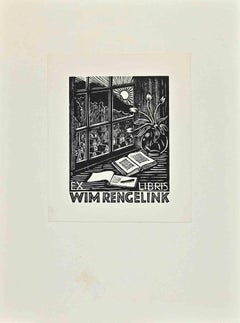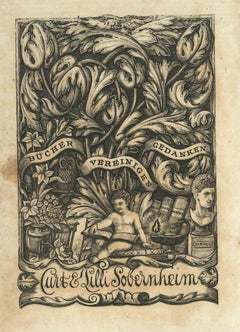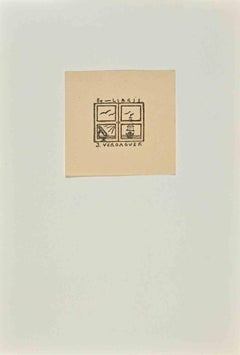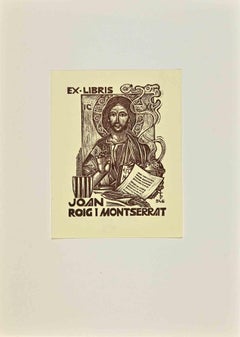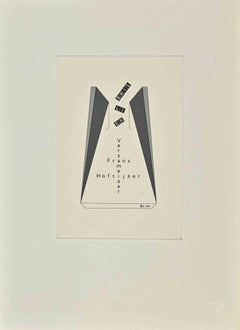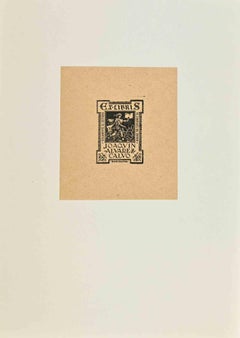Symbolist Figurative Prints
to
137
413
26
72
1
2
Overall Width
to
Overall Height
to
15,563
8,003
2,621
2,436
2,253
1,000
944
734
667
408
323
112
93
37
96
38
36
34
33
2
77
436
1
11
94
92
82
7
4
2
2
6
3
368
140
5
363
222
176
107
97
79
69
35
31
29
27
25
24
18
17
15
12
12
11
11
198
108
98
84
55
25
306
306
101
Style: Symbolist
Ex Libris - Wim Rengelink - Woodcut - 1989
Located in Roma, IT
Ex Libris - Wim Rengelink is a Modern Artwork realized in 1989.
B/W woodcut on paper.
The work is glued on cardboard.
Total dimensions: 20x 15 cm.
Excellent conditions .
...
Category
1890s Symbolist Figurative Prints
Materials
Woodcut
Cupid and Motifs - Woodcut Print - Early 20th century
Located in Roma, IT
Cupid and Motifs is a woodcut print realized by the Anonymous artist in the early 20th century.
Good conditions with slight foxing.
Beautiful tiny and delicate artwork realized by ...
Category
Early 20th Century Symbolist Figurative Prints
Materials
Woodcut
$141 Sale Price
40% Off
Ex Libris J. Veroaguer - Woodcut Print - Mid-20th Century
Located in Roma, IT
Ex Libris J. Veroaguer is a Modern Artwork realized in mid 20th Century.
B/W woodcut on paper.
The work is glued on cardboard.
Total dimensions: 21 x 15 cm.
Mint condition...
Category
Mid-20th Century Symbolist Figurative Prints
Materials
Woodcut
$127 Sale Price
40% Off
Ex Libris Joan Roig I Montserrat - Woodcut Print - Mid-20th Century
Located in Roma, IT
Ex Libris Joan Roig I Montserrat is a Modern Artwork realized in mid 20th Century.
Ex Libris. B/W woodcut on paper.
The work is glued on cardboard.
Total dimensions: 21 x 1...
Category
Mid-20th Century Symbolist Figurative Prints
Materials
Woodcut
$141 Sale Price
40% Off
Ex Libris - Woodcut Print - Mid-20th Century
Located in Roma, IT
Ex Libris is a woodcut print on paper. The work is glued on cardboard.
Total dimensions: 20 x 14.5 cm.
The artwork represents a minimalistic, clean design, a abstract shape , throu...
Category
Mid-20th Century Symbolist Figurative Prints
Materials
Woodcut
$169 Sale Price
40% Off
Ex Libris Joaquin Alvarez Calvo - Woodcut Print - Mid-20th Century
Located in Roma, IT
Ex Libris Joaquin Alvarez Calvo is a woodcut print on ivory-colored paper. The work is glued on cardboard.
Total dimensions: 21 x 15.5 cm.
The artwork represents a figure who holds...
Category
Mid-20th Century Symbolist Figurative Prints
Materials
Woodcut
$127 Sale Price
40% Off
Eva's Apples - Woodcut print by Michel Fingesten - 1936
Located in Roma, IT
Eve's Apples is an woodcut realized by Michel Fingesten in 1930s.
Woodcut showing Eve while handing apples. Below a card with number 86 and Fingesten signature.
Includes matte.
...
Category
1930s Symbolist Figurative Prints
Materials
Woodcut
Illustration from the series "Les Fleurs du Mal" after Odilon Redon - 1923
By Odilon Redon
Located in Roma, IT
Illustration from the series "Les Fleurs du Mal" is an etching print realized after Odilon Redon and published by Henri Felury in 1923.
Monogrammed in the plate.
Good conditions.
...
Category
1920s Symbolist Figurative Prints
Materials
Lithograph
Ballerinas - Photolithograph After Constantin Guys - Early 20th Century
Located in Roma, IT
Ballerinas is a photolithograph print on ivory-colored paper, glued on a greenish Passepartout realized in the early 20 century After Constantin Guys
Good conditions.
The critical ...
Category
Early 20th Century Symbolist Figurative Prints
Materials
Lithograph
BOSBOOM. 1917.
Located in New York, NY
ROLAND HOLST, R.N. (Richard) (1868-1938). “Eere Tentoonstelling Bosboom/ 1817 1917/ Pulchri-Studio ‘s Gravenhage/ 21 Apr[il] 31 Mei”. Color lithograph (pa...
Category
1910s Symbolist Figurative Prints
Materials
Lithograph
Ex Libris PF - Woodcut by Michel Fingesten - 1936
Located in Roma, IT
Ex Libris PF is a woodcut print by Michel Fingesten, realized in 1936.
Hand signed, included a white cardboard passpartout (30x24 cm).
In excellent conditions: As good as new.
Michel Fingesten (1884 - 1943) was a Czech painter and engraver of Jewish origin. He is considered one of the greatest Ex Libris artists in history. From an Austrian weaver father and a Jewish mother...
Category
Early 20th Century Symbolist Figurative Prints
Materials
Woodcut
Ex Libris Gigi Raimondo - Etching by Michel Fingesten - 1937
Located in Roma, IT
Ex Libris Gigi Raimondo is an Etching by Michel Fingesten, in 1937.
Hand signed with pencil, included a white cardboard passpartout (30x24 cm).
In excellent conditions: As good as new.
Michel Fingesten (1884 - 1943) was a Czech painter and engraver of Jewish origin. He is considered one of the greatest Ex Libris artists in history. From an Austrian weaver father and a Jewish mother from Trieste. At 16 he studied at the Vienna Academy, together with Oskar Kokoschka. From 1902 to 1906 he wandered around America, and then Australia, before arriving in Palermo in 1907. He went up the peninsula via Trieste and returning to Germany, first settling in Munich in Franz von Stuck's studio, practicing caricature and small format graphics and then in Berlin.
In 1913 he began to record. He returned to Italy in 1935 to visit his maternal relatives from Trieste and remained there because of the racial persecutions to which the Jews in Silesia were subject, settling in Milan. In this period he recorded about 500 exlibris. On 9 October 1940 he was arrested and interned as a foreigner in the camp of Civitella del Tronto and then of Ferramonti, (Cosenza) from November 1941 and will be accused by the Nazis of having painted degenerate art...
Category
Early 20th Century Symbolist Figurative Prints
Materials
Etching
Ex Libris G.B. - Woodcut by Michel Fingesten - 1937
Located in Roma, IT
Ex Libris G.B. is a woodcut print by Michel Fingesten, in 1937.
Hand signed , included a white cardboard passpartout (30x24 cm).
In excellent conditions: As good as new.
Michel Fingesten (1884 - 1943) was a Czech painter and engraver of Jewish origin. He is considered one of the greatest Ex Libris artists in history. From an Austrian weaver father and a Jewish mother from Trieste. At 16 he studied at the Vienna Academy, together with Oskar Kokoschka. From 1902 to 1906 he wandered around America, and then Australia, before arriving in Palermo in 1907. He went up the peninsula via Trieste and returning to Germany, first settling in Munich in Franz von Stuck's studio, practicing caricature and small format graphics and then in Berlin.
In 1913 he began to record. He returned to Italy in 1935 to visit his maternal relatives from Trieste and remained there because of the racial persecutions to which the Jews in Silesia were subject, settling in Milan. In this period he recorded about 500 exlibris. On 9 October 1940 he was arrested and interned as a foreigner in the camp of Civitella del Tronto and then of Ferramonti, (Cosenza) from November 1941 and will be accused by the Nazis of having painted degenerate art ("Entartete Kunst...
Category
Early 20th Century Symbolist Figurative Prints
Materials
Woodcut
Le Fondeur Paris [Steel Worker]
Located in New York, NY
Carriere, Eugene. Le Fondeur, Paris 1900 [Steel Worker], Color lithograph.
Ref: Das Fruhe Plakat 134. 51 x 34 3/4 inches.
Eugène Anatole Ca...
Category
Early 1900s Symbolist Figurative Prints
Materials
Lithograph
Antoine Georges Marie Rochgrosse
Located in New York, NY
Rochgrosse, Antoine Georges Marie. Poems Chantes/Gustave Carpentier /Paris/Henri Tellier, Editeur. 1896. 7 Color lithograph.
Das fruhe Plakat 750 (Music Sheet).
French painter, pri...
Category
1880s Symbolist Figurative Prints
Materials
Lithograph
Deutsches Dichterjubilaum - Rare Book Illustrated by Hans Steiner - 1923
Located in Roma, IT
Deutsches Dichterjubilaum is a book written by Arno Holz (1863 – 1929) and illustrated by Hans Steiner (1907-1962) and in 1923.
Original First Edition.
Published by Werkverlag, Be...
Category
1920s Symbolist Figurative Prints
Materials
Paper, Photogravure
Ex Libris Naclowski - Woodcut Print - Early 20th Century
Located in Roma, IT
Ex Libris Naclowski is an original Contemporary Artwork realized in the early 20th Century.
Original B/W woodcut print on ivory-colored paper.
The work is glued on cardboard.
...
Category
Early 20th Century Symbolist Figurative Prints
Materials
Woodcut
Ex Libris - Cross - Original Woodcut by Michel Fingesten - Early 20th Century
Located in Roma, IT
"Ex Libris - Cross" is an original woodcut on paper realized by Michel Fingesten, Early 20th Century. Hand signed and with hand notes in pencil on the lower.
In good conditions, exce...
Category
Early 20th Century Symbolist Figurative Prints
Materials
Woodcut
Ex Libris "GB" . Original woodcut print by M. Fingesten - Early 20th Century
Located in Roma, IT
Original woodcut print on paper. Very good conditions. Includes passepartout.
Image Dimensions : 10.7 x 11.3 cm
Michel Fingesten (Butzkowitz, 1884 - Cerisano, 1943) was a Czech pai...
Category
Early 20th Century Symbolist Figurative Prints
Materials
Woodcut
Ex Libris RS - Woodcut by Michel Fingesten - Early 20th Century
Located in Roma, IT
"Ex Libris RS" is an original woodcut artwork on creamy paper by Michel Fingesten, Early 20th Century.
Hand-signed on the lower right and with notes in pencil.
In excellent conditio...
Category
Early 20th Century Symbolist Figurative Prints
Materials
Woodcut
Meeting - Original Photogravure by Constantine Guys - 1850s
Located in Roma, IT
Meeting is a wonderful original print on brownish paper, realized by the French artist, Constantin Guys (1802 -1892).
In very good condition, including a pet...
Category
1850s Symbolist Figurative Prints
Materials
Photogravure
$206 Sale Price
30% Off
Auferstehung - Héliogravure by Franz von Bayros - 1920s
Located in Roma, IT
"Auferstehung" is an original Black and white héliogravure on cream-colored cardboard realized by Choisy Le Conin, pseudonym of Franz Von Bayros (Agram, 1866 – Vienna, 1924).
From M...
Category
1920s Symbolist Figurative Prints
Materials
Engraving
Sankt Franziskus - Héliogravure by Franz von Bayros - 20th Century
Located in Roma, IT
"Sankt Franziskus" is an original Black and white héliogravure on cream-colored cardboard realized by Choisy Le Conin, pseudonym of Franz Von Bayros (Agram, 1866 – Vienna, 1924).
F...
Category
Early 20th Century Symbolist Figurative Prints
Materials
Engraving
Die Tanzerin Gertrud Bodenwieser Héliogravure by Franz von Bayros - 20th Century
Located in Roma, IT
"Die Tanzerin Gertrud Bodenwieser" is an original colored héliogravure on cream-colored cardboard realized by Choisy Le Conin, pseudonym of Franz Von Bayros (Agram, 1866 – Vienna, 1...
Category
Early 20th Century Symbolist Figurative Prints
Materials
Engraving
Lugenbrucke - Vintage Héliogravure by Franz von Bayros - Early 20th Century
Located in Roma, IT
"Lugenbrucke" is an original Black and white héliogravure on cream-colored cardboard realized by Choisy Le Conin, pseudonym of Franz Von Bayros (Agram, 1866 – Vienna, 1924).
From M...
Category
Early 20th Century Symbolist Figurative Prints
Materials
Engraving
Der Abend - Vintage Héliogravure by Franz von Bayros - Early 1900
Located in Roma, IT
"Der Abend" is a Black and white héliogravure on cream-colored cardboard realized by Choisy Le Conin, pseudonym of Franz Von Bayros (Agram, 1866 – Vienna, 1924).
From Mappe, a port...
Category
Early 20th Century Symbolist Figurative Prints
Materials
Engraving
Dante - Vintage Héliogravure by Franz von Bayros - Early 20th Century
Located in Roma, IT
"Dante" is an original Black and white héliogravure on cream-colored cardboard realized by Choisy Le Conin, pseudonym of Franz Von Bayros (Agram, 1866 – Vienna, 1924).
From Mappe, a...
Category
Early 20th Century Symbolist Figurative Prints
Materials
Engraving
Ex Libris - Woodcut by M. Fingesten - Early 1900
Located in Roma, IT
Ex Libris is an original woodcut print realized by Michel Fingesten.
Hand-signed on the lower center and hand written notes.
Mint conditions.
Sheet Dimension: 17.3 x11
Ex Libri...
Category
Early 20th Century Symbolist Figurative Prints
Materials
Woodcut
$619 Sale Price
30% Off
Fruhling - Original Woodcut After Arnold Bocklin - 1890s
Located in Roma, IT
Frühling is a wonderful black and white photogravure of the original painting by Arnold Böcklin (Basel 1827 - Fiesole 1901), probably edited by Bruckman...
Category
1890s Symbolist Figurative Prints
Materials
Lithograph
Simplicius Among Soldiers - Original Etching by M. Klinger - 1881
By Max Klinger
Located in Roma, IT
Image dimensions: 26.5 x 42.5 cm.
Simplicius Among Soldiers from "Intermezzi" is an original print realized by Max Klinger in 1881.
Signature and number of the print on plate.
Bla...
Category
1880s Symbolist Figurative Prints
Materials
Etching, Aquatint
Rosenwalzer - Vintage Héliogravure by Franz von Bayros - 1921 ca.
Located in Roma, IT
Rosenwalzer is a colored cliché from watercolor on cream-colored cardboard realized by Choisy Le Conin, as is remembered Franz Von Bayros (Agram, 1866 – Vienna, 1924).
From Mappe, a...
Category
1920s Symbolist Figurative Prints
Materials
Engraving
"L'Etendard de la Vigilance, " Original Etching & Serigraph signed by Joel Cazaux
Located in Milwaukee, WI
"L'Etendard De La Vigilance" is an original etching and serigraph by Joel Cazaux. The artist signed the piece lower right, and wrote the edition number 38/100 in the lower left, and ...
Category
1970s Symbolist Figurative Prints
Materials
Etching, Screen
Abel Pann Israeli Bezalel School Lithograph Judaica Biblical Print Jewish Art
By Abel Pann
Located in Surfside, FL
Abel Pann (1883–1963) was a European Jewish painter who settled in the Talpiot neighborhood of Jerusalem in the early twentieth century and taught at the Bezalel Academy of Art under...
Category
Mid-20th Century Symbolist Figurative Prints
Materials
Lithograph
Abel Pann Israeli Bezalel School Lithograph Judaica Biblical Print Jewish Art
By Abel Pann
Located in Surfside, FL
Abel Pann (1883–1963) was a European Jewish painter who settled in the Talpiot neighborhood of Jerusalem in the early twentieth century and taught at the Bezalel Academy of Art under...
Category
Mid-20th Century Symbolist Figurative Prints
Materials
Lithograph
Abel Pann Israeli Bezalel School Lithograph Judaica Biblical Print Jewish Art
By Abel Pann
Located in Surfside, FL
Abel Pann (1883–1963) was a European Jewish painter who settled in the Talpiot neighborhood of Jerusalem in the early twentieth century and taught at the Bezalel Academy of Art under...
Category
Mid-20th Century Symbolist Figurative Prints
Materials
Lithograph
Eve
Located in West Hollywood, CA
A magnificent, rare original etching by Scottish artist William Russell Flint.
This etching was just acquired from the estate of an important American artist where it has resided fo...
Category
18th Century and Earlier Symbolist Figurative Prints
Materials
Etching
Price Upon Request
Symbolist figurative prints for sale on 1stDibs.
Find a wide variety of authentic Symbolist figurative prints available for sale on 1stDibs. Works in this style were very popular during the 21st Century and Contemporary, but contemporary artists have continued to produce works inspired by this movement. If you’re looking to add figurative prints created in this style to introduce contrast in an otherwise neutral space in your home, the works available on 1stDibs include elements of blue, orange and other colors. Many Pop art paintings were created by popular artists on 1stDibs, including Michel Fingesten, Abel Pann, Franz von Bayros (Choisi Le Conin), and Ferdinand Hodler & R. Piper & Co.. Frequently made by artists working with Lithograph, and Woodcut Print and other materials, all of these pieces for sale are unique and have attracted attention over the years. Not every interior allows for large Symbolist figurative prints, so small editions measuring 1.58 inches across are also available. Prices for figurative prints made by famous or emerging artists can differ depending on medium, time period and other attributes. On 1stDibs, the price for these items starts at $55 and tops out at $378,675, while the average work sells for $436.
Recently Viewed
View AllMore Ways To Browse
Edward Simmons
Edwin Lord Weeks
Elizabeth Enders
Elizabeth Horning
Emil Holzhauer
England Church Oil Painting
English Deer Painting
English Fox Hunt Painting
English Toy Terrier
Enrique Martinez Celaya
Eric Aho
Eritrea Art
Ernest Chateignon
Erotic Art Animal
Eugene Chigot
Eugene Devaud De Madelin
Eugene Jardin
Faith Sheppard
